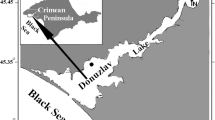Abstract
Growth and pearl production were compared for males and females in the freshwater mussel, Hyriopis cumingii, from a full-sib family. The results indicated that there was no significant difference (p > 0.05) on individual weight between male and female mussels of 1- or 2-year-old, while significant difference (p < 0.01) lay among 3- or 4-year-old mussels with male greater than female. The average shell width of the male mussels was less than that of the female individual (p < 0.05). 1- and 2-year-old males and females did not differ significantly with respect to the total weights, grain weights, or grain sizes of the pearls they produced, but these three parameters were all significantly greater in 3- and 4-year-old males (p < 0.05). The round pearl percent were similar between male and females at ages 1, 2, 3 and 4 years. Male and female mussels were separately and mixed cultured in enclosures, respectively. The rates of growth in shell width and body weight of females separated from males were 3.42 and 4.16 %, respectively, higher than in females mixed with males (p < 0.05). The total pearl weight per mussel, the average weight per pearl, and the average pearl size of females separated from males were 6.61, 7.10, and 3.59 %, respectively, greater than in females mixed with males (p < 0.05). There was no significant difference in the growth rate or pearl yield of males cultured with or without females (p > 0.05). Under traditional culture methods, male mussels have a better pearl performance, and artificial separation of females from males can improve the growth and pearl production of female mussels.




Similar content being viewed by others
References
Alagaraja K (1962) Observations on the length-weight relationship of pearl oysters. J Mar Biol Assoc India 4:198–205
Bai Z, Li J, Wang G (2008) Relationship of pearl production performance and growth traits and inserted parts of Hyriopsis cumingii. J Fish Sci China 15:493–499
Bai ZY, Yin YX, Hu S (2009) Identification of genes involved in immune response, Microsatellite, and SNP markers from expressed sequence tags generated from hemocytes of Freshwater Pearl Mussel (Hyriopsis cumingii). Biotechnology 11(4):520–530
Bayne BL, Newell RC (1983) Physiological energetics of marine mollusca. In: Saleudin ASM, Wilbur KM (eds) Physiology. The Mollusca, vol 4, Part I. Academic Press, New York, pp 407–515
Cai YY, Zhang Y, Wei RF (1995) The conspectus of seashell. The physiology of seashell. Shanghai Science and Technology Press, Shanghai, pp 153–155
Cal RM, Vidal S, Martínez P, Álvarez-Blázquez B, Gómez C, Piferrer F (2006) Growth and gonadal development of gynogenetic diploid Scophthalmus maximus. J Fish Biol 68:401–413
Chen M, He J (1994) Changes of breeding period of bay scallop, Argopecten irradians in South China. J Oceanogr Taiwan Strait 13(2):118–123
He F, Xiang J (2005) Operation technology of culture of non-nucleated pearl. Heibei Fish 3:27–28
Hu JX (ed) (1992) The seed biology of pearl oyster. In: The production of pearl oysters. Ocean Press, Beijing, pp 20–23
Imsland AK, Folkvord A, Grung GL, Stefansson SO, Taranger GL (1997) Sexual dimorphism in growth and maturation of turbot, Scophthalmus maximus (Rafinesque, 1810). Aquac Res 28:101–114
Li JL, Li YS (2009) Aquaculture in China—Freshwater pearl culture. World Aquac 40:60–62
Li JL, Wang GL, Bai ZY (2009) Genetic variability in four wild and two farmed stocks of the Chinese freshwater pearl mussel (Hyriopsis cumingii) estimated by microsatellite DNA markers. Aquaculture 287:286–291
Lu D, Tao J, Cao X (2002) GBEF 18781–2002 Classification of cultured pearls. Standard Press of China, Beijing, pp 61–71
Pan B, Li J, Bai Z (2010) Histological study on ovarian development and oogenesis of Hyriopsis cumingii cultured in the pond. J Shanghai Ocean Univ 19:452–456
Qiu A, Shi A (1999) Impact of different pH on the secretion of nacre of Hyriopsis cumingii. Curr Zool 45:361–370
Qui G (1998) (1998) A review of genetics and breeding in shrimp (prawns) and crabs. J Fish China 3:265–274
Tankersley RA, Dimock RV Jr (1992) Quantitative analysis of the structure and function of the marsupial gills of the freshwater mussel Anodonta cataracta. Biol Bull 182:145–154
Tankersley RA, Dimock RV Jr (1993) The effect of larval brooding on the filtration rate and particle-retention efficiency of Pyganodon cataracta (Bivalvia: Unionidae). Can J Zool 71:1934–1944
Wang Y, Xie N, Lin Q, Gao J (2009) Water environment, and growth and pearl production amount of Hyriopsis cumingii in cultured pond of Zhuji. Freshw Fish 39:68–71
Wen H, Gu R, Hua D, Hu D, Xu G, Xu P (2011) The study progress of genetic breeding of Hyriopsis cumingii. J Yangtze Univ 1:233–239
Xie N, Li Y, Zheng H, Wang G, Li J, Qi N, Yuan W (2006) Comparison of culture effects and pearl production performance among Hyriopsis cumingii, Hyriopsis schlegelii and hybridized F1 generation. J Shanghai Ocean Univ 15:264–269
Yan LL, Zhang GF, Liu QG et al (2009) Optimization of culturing the freshwater pearl mussels, Hyriopsis cumingii with filter feeding Chinese carps(bighead carp and silver carp)by orthogonal array design. Aquaculture 292:60–66
Yang Y, Lin K, Zhang Z et al (1982) (1982) Growth comparison experiment of the male Mozambique tilapia. Freshw Fish 3:17–19
Zhang G (2005) Pearl culture of mussel. China Agricultural Press, Beijing, pp 58–59
Zhang G, Ding A, Lu X, Fang A (2002) Initial study of most suitable insertion of pearly mussel. Fish Sci Technol Inf 29:258–259
Acknowledgments
This work was supported by the Shanghai Universities Knowledge Service Platform (ZF1206), Key Technologies R&D Program of China (2012BAD26B04) and the National Natural Science Foundation of China (31272657).
Author information
Authors and Affiliations
Corresponding author
Rights and permissions
About this article
Cite this article
Zhao, Y., Bai, Z., Fu, L. et al. Comparison of growth and pearl production in males and females of the freshwater mussel, Hyriopsis cumingii, in China. Aquacult Int 21, 1301–1310 (2013). https://doi.org/10.1007/s10499-013-9632-y
Received:
Accepted:
Published:
Issue Date:
DOI: https://doi.org/10.1007/s10499-013-9632-y




